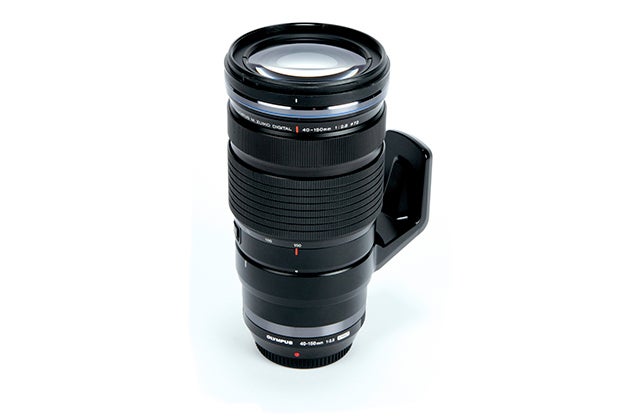A sure thing or off the pace? Michael Topham lays the odds on the Olympus M.Zuiko Digital ED 40-150mm f/2.8 Pro, which promises a blisteringly fast performance
 Olympus M.Zuiko Digital ED 40-150mm f/2.8 Pro at a glance:
Olympus M.Zuiko Digital ED 40-150mm f/2.8 Pro at a glance:
- 16 lens elements in 10 groups
- 0.7m minimum focus distance
- 9 aperture blades
- 72mm filter thread
- Dimensions 79.4 x 160mm
- Weight 760g
- Price £1,299
When Olympus took the wraps off the OM-D E-M1 back in September 2013, the manufacturer also revealed that there would be a pair of top-line, pro-spec lenses arriving to support it. The first of these – the M.Zuiko Digital ED 12-40mm f/2.8 – arrived at the time the OM-D E-M1 was released, but we’ve had to wait a little more patiently for the M.Zuiko Digital ED 40-150mm f/2.8 Pro to be unveiled.
Following Olympus’s promise of a release date in the latter half of 2014, the first production samples of the 40-150mm f/2.8 have finally started to hit UK shores. I was given the opportunity to join Olympus to try out the lens in a sporting environment for which the lens is designed, so I charged the batteries on my OM-D E-M1 and headed to Cheltenham Racecourse.
Specification
The Olympus M.Zuiko Digital ED 40-150mm f/2.8 Pro has been designed to meet the expectations of serious micro four thirds users who demand a long zoom and the type of ruggedness you’d expect from a lens with a four-figure price tag. Although it’s not the first M.Zuiko Pro-series lens to feature a dust, splash and freezeproof construction (that honour goes to the M.Zuiko Digital ED 12-40mm f/2.8), it’s the first telephoto lens in the range that’s been made to withstand the severity of professional use. Its main appeal will lie with OM-D E-M1 users who have a fully weather-sealed body, not forgetting Panasonic Lumix DMC-GH4 users who also benefit from a body with many seals to protect against inclement weather or dust reaching, or potentially damaging, the internals. Panasonic GH4 users should take note, however, that the lens won’t be stabilised in any way or form.
Maintaining a maximum aperture of f/2.8 across its zoom range, the lens is constructed from 16 elements in 10 groups, including one aspherical ED, two aspherical, one HD, one SED and three ED lenses. The focusing system relies on a dual linear voice coil motor design (VCM) to deliver quiet and fast performance, and with a minimum focus distance of 70cm and an inner zoom mechanism that allows it to be no longer than 160mm, this is shaping up – on paper, at least – to be one of the most impressive micro four thirds telephoto lenses currently available.
 Image: Opening the aperture fully to f/2.8 created pleasing background blur to this mono shot
Image: Opening the aperture fully to f/2.8 created pleasing background blur to this mono shot
Function button and hood
While buttons on the barrel aren’t anything new, this lens has a function button that allows you
to control the way you set up the camera’s function buttons. In addition, the sizeable lens hood
is the manufacturer’s second hood with a retractable design.
It’s ingenious in the way it works: twist the hood’s release ring anticlockwise from behind the camera and it effortlessly pulls in towards the camera body, protecting both the push-pull AF/MF control ring and the zoom ring when not in use. It also saves you from having to remove the lens hood and invert it for storage or transportation purposes. The only downfall of this unique lens hood design is that when it’s retracted and pulled back, it obscures the zoom ring making it difficult to use. When the hood isn’t required, it’s best to remove it altogether.
Build
The all-metal construction of this 40-150mm lens oozes strength and rigidity, as you’d expect.
Just like the M.Zuiko Digital ED 12-40mm f/2.8, it complements the build quality of the OM-D E-M1 and manages to feel at one with the camera. Professional lenses are always expected to be able to survive a bit of a battering from their users, and there’s nothing to suggest that this 40-150mm lens will get damaged easily. Even a collision with a solid spectator barrier, albeit a glancing blow, failed to damage the lens in any way during my time with it.
Storm clouds and drizzle early in the day looked like the perfect conditions for putting the lens’s weather sealing to the test, but the sun broke through in true British fashion. Back in the office, I saturated the lens (while coupled to the OM-D E-M1) using a watering can for several minutes, and it passed this test with flying colours. Users looking for a filter to protect the front element from accidental knocks and scrapes will also be interested in the PRF-ZD72 Pro – a filter specially designed for the lens that incorporated ZERO (Zuiko Extra-low Reflection Optical) coatings to minimise ghosting and flare, although unfortunately, it was not available to me during testing.
 Image: This shot was taken at a focal length of 150mm – equivalent to 300mm attached to the OM-D E-M1
Image: This shot was taken at a focal length of 150mm – equivalent to 300mm attached to the OM-D E-M1
Autofocus
It’s the speed of the autofocus, as well as the image quality, of course, that Olympus users will be most eager to read about. In use, and in both single and continuous AF, the 40-150mm f/2.8 showed barely any sign of hesitation locking onto fast-moving subjects – even when tracking racehorses galloping on their approach to the finish line. The autofocus is very fast indeed, which is great news for sports and wildlife photographers who require the split-second lock-on speeds that spell the difference between successfully bagging a sharp shot or not.
In use
The 40-150mm f/2.8 is particularly pleasing to operate. Everything from its smooth zoom ring to its push-pull AF/MF ring works well. The zoom-ring motion is as smooth at its widest focal length as it is at full telephoto and offers a lovely fluidity that I found just a fraction stiffer than the AF/MF focus ring. Focus-distance markings are revealed as the AF/MF focus ring is snapped back towards the body, while the tripod collar rotates freely once loosened. It doesn’t notch into place as it rotates like some lenses, although the white dots and white line on the collar itself are aligned easily enough. The size of the focus ring is fairly modest compared to the large zoom ring, but this didn’t prove to be a cause for concern in use.
 Image: he lens is highly versatile and is as good at capturing candids as it is action
Image: he lens is highly versatile and is as good at capturing candids as it is action
Best ever?
While the price of the lens (£1,299, or £1,499 with a 1.4x converter thrown in) may see it creep only into the most serious user’s kit bags, the Olympus M.Zuiko Digital ED 40-150mm f/2.8 Pro is certainly an optic to get micro four thirds users excited. The three hours I spent with it convinced me that it is one of the best and most enjoyable micro four thirds lenses I have ever used.
When I first picked it up, I couldn’t believe how small this lens is for a telephoto that covers such an impressive range, and with such a large maximum aperture. This translates to a huge weight saving over other telephoto zooms and works out at close to half the weight of Canon’s 70-200mm f/2.8L IS II USM lens. It’s a more manageable lens to transport too, which was especially noticeable when I was holding the camera and lens up to my eye for long durations, or when it was slung over my shoulder. Add to this its ability to resolve the finer details in the frame and I’m left with a lasting impression that the Olympus M.Zuiko Digital ED 40-150mm f/2.8 Pro is an absolute stunner.





